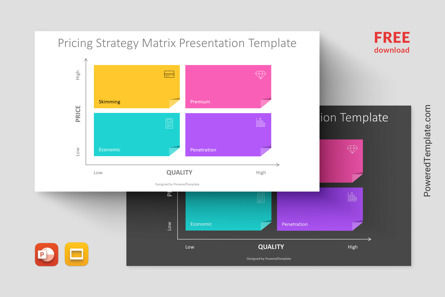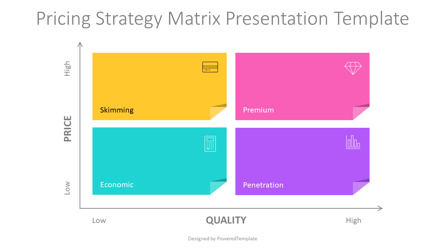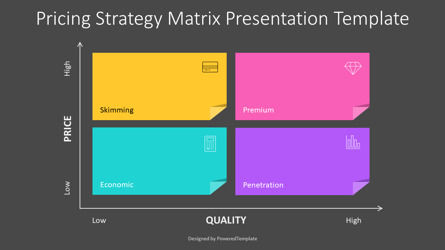Free Google Slides Theme and PowerPoint Template
Uncover the intricacies of pricing strategies with our free presentation template - Pricing Strategy Chart, masterfully crafted to visualize the relationship between quality and price. Designed for seamless integration with both PowerPoint and Google Slides, this template showcases a chart populated with four distinct colored rectangles, each representing a unique pricing strategy: Skimming, Premium, Economic, and Penetration. Each rectangle is adorned with a corresponding icon, enriching the visual experience and aiding in quick comprehension. The X-axis traverses the spectrum of quality from low to high, while the Y-axis measures price in a similar gradient.Pricing strategy refers to the method or approach a business uses to set the price for its product or service. It is an essential aspect of marketing and business strategy, as it determines how much value is captured from the market and impacts a company's profitability, market share, and brand positioning. The right pricing strategy can drive sales and foster growth, while the wrong one can deter customers and harm the brand.
Several factors influence pricing strategy, including:
- 1. Costs: This includes both fixed and variable costs associated with producing the product.
- 2. Competitors' Prices: Understanding what competitors charge can help businesses position themselves in the market.
- 3. Customer Demand: Pricing can be influenced by how much customers value the product and their willingness to pay.
- 4. Brand Position: A premium brand may charge higher prices because of the perceived value associated with its brand.
- 5. Market Conditions: Economic factors, seasonality, and other external events can influence pricing.
- 6. Product Lifecycle: New products might have different pricing strategies than established products or products nearing the end of their life.
Here are some common pricing strategies:
- 1. Cost-Plus Pricing: The price is determined by adding a fixed margin or percentage to the total cost of producing the product.
- 2. Competitive Pricing: The price is set based on what competitors are charging, either matching, undercutting, or going above their prices.
- 3. Penetration Pricing: Setting a low initial price to quickly gain a large market share. The price may increase later as market share grows or costs are recovered.
- 4. Skimming: Setting a high initial price for a new product, especially if it's innovative. As competition enters the market, the price may gradually drop.
- 5. Value-Based Pricing: Setting the price based on the perceived value to the customer rather than the cost of the product.
- 6. Freemium: Offering basic services for free while charging for advanced features or functionalities.
- 7. Dynamic Pricing: Adjusting prices based on real-time demand, competitor prices, or other external factors. Common in industries like airlines and hotels.
- 8. Psychological Pricing: Setting prices in a way that appeals to a consumer’s emotional responses, such as pricing something at $9.99 instead of $10.
Choosing the right pricing strategy requires an understanding of your business's goals, the market environment, your target audience, and how your product fits within that landscape. Over time, businesses may need to adjust their pricing strategies as these factors change.
Whether you're a business analyst presenting market positioning, an educator elucidating the nuances of product pricing, or a startup pitching a new product, this template is your key to delivering a clear and compelling message.






